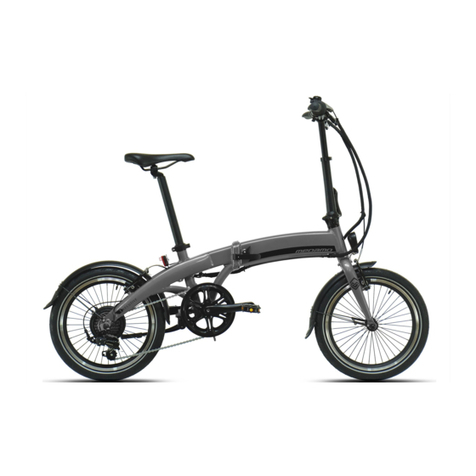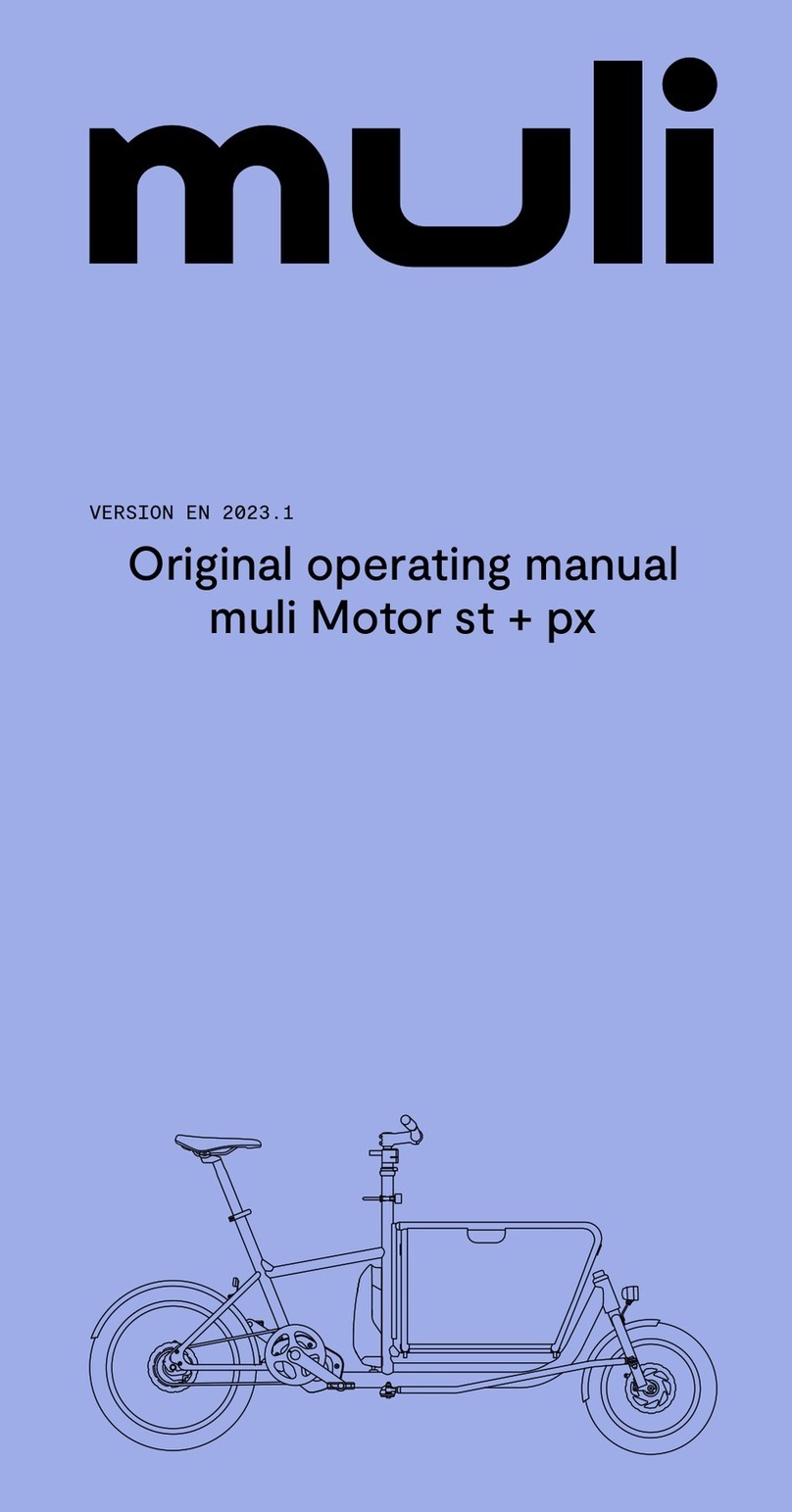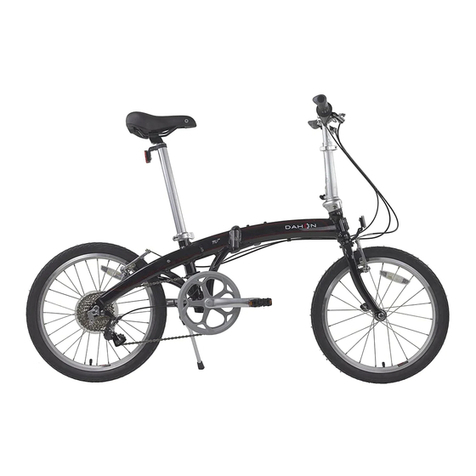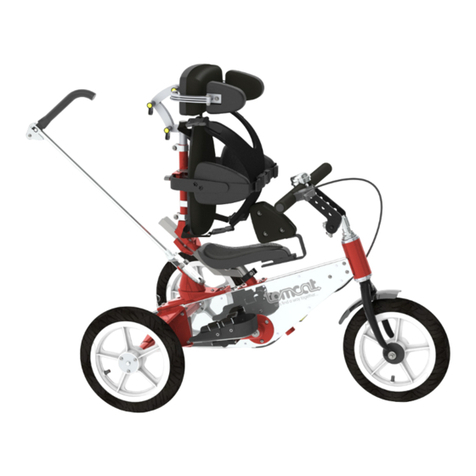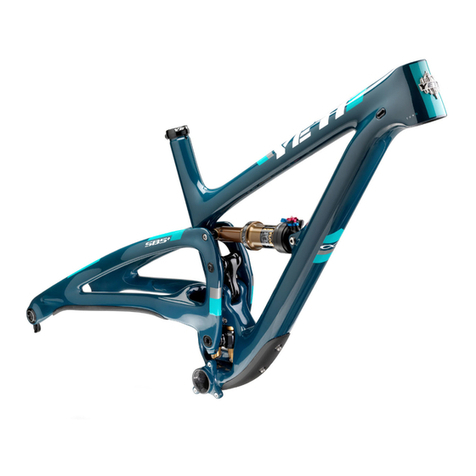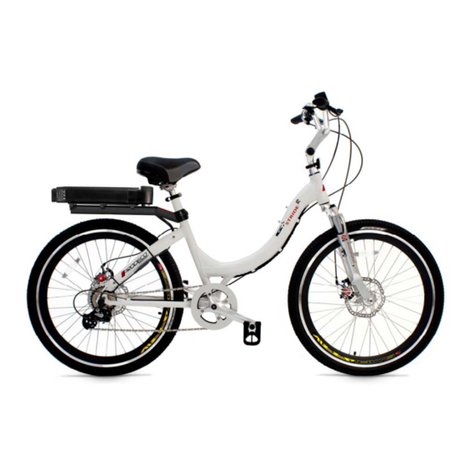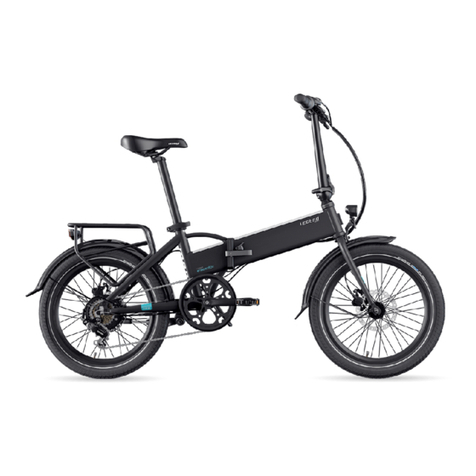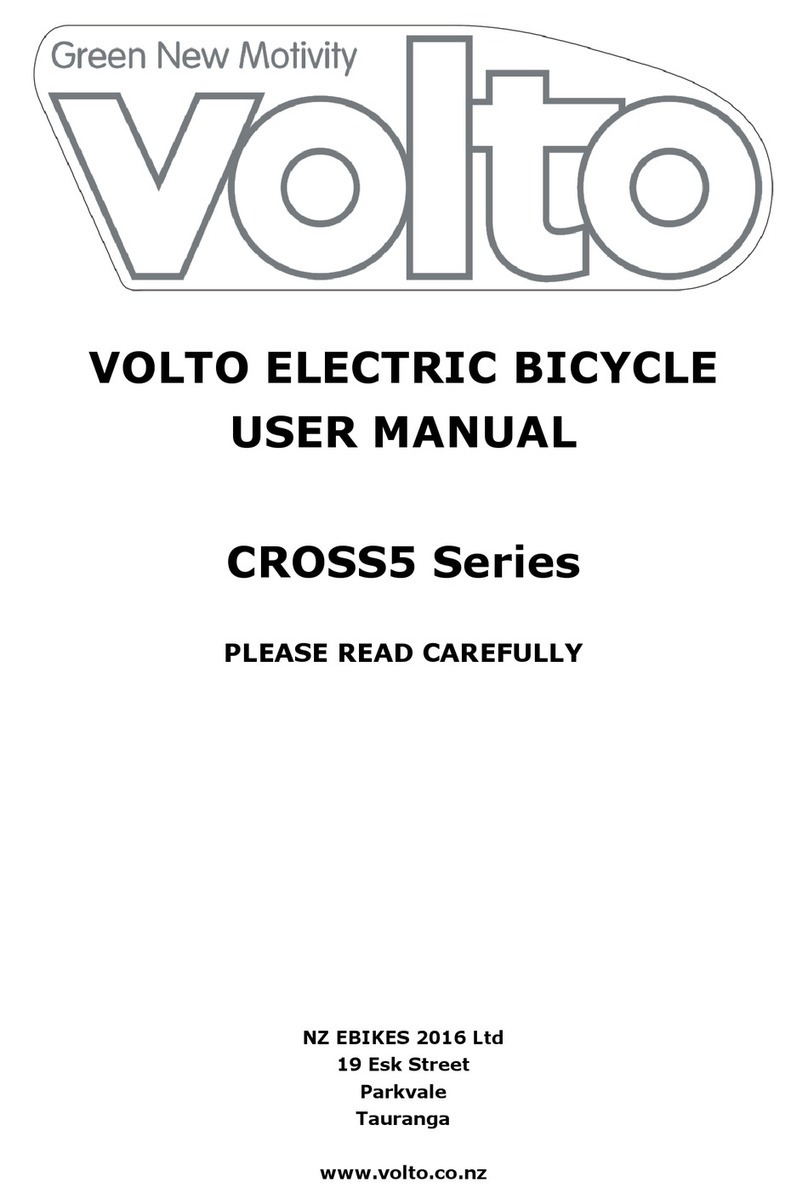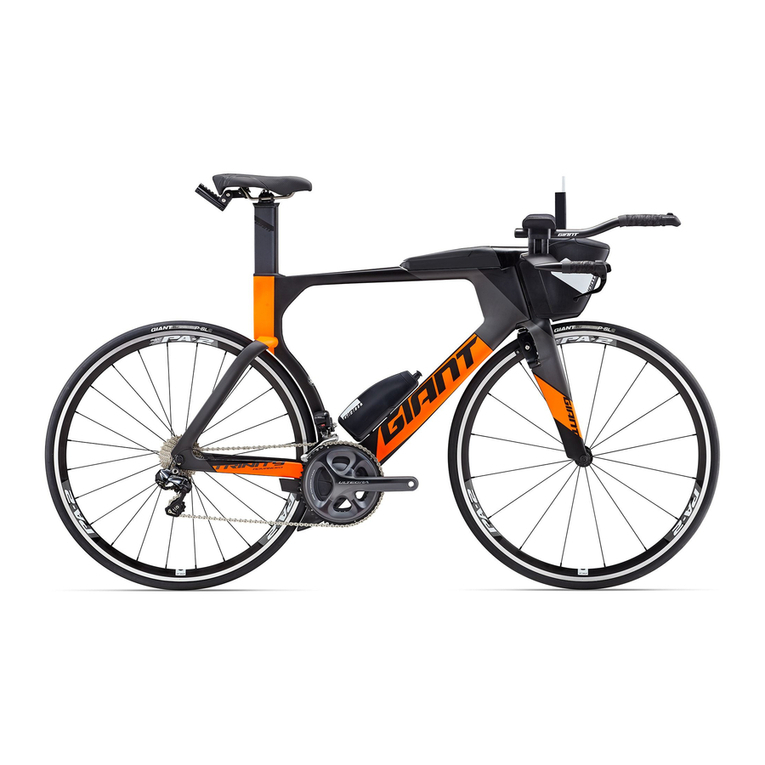Gary Fisher Cronos Operating and installation instructions

| pitchbook2010
2010

2 | GARY FISHER SERVICE INFORMATION
Service Information
The Gary Fisher Cronus is the lightest, strongest frameset we have ever made.
To accomplish this, we have used shaped and very thin-walled carbon tubes. Because
of its unique features, the Gary Fisher Cronus requires different or additional
assembly techniques, provided here:
+ Carbon ber care
+ Headset bearing installation
+ Front hub and fork integration
+ Bottom bracket bearing installation for a variety of bottom bracket types
Check www.fisherbikes.com for updates.
These instructions are written for an experienced mechanic. If you need further
information, refer to your bicycle owner’s manual, the instructions in a bicycle
mechanic’s handbook, or consult your dealer.
Please save these instructions for future reference.

3 | GARY FISHER SERVICE INFORMATION
Working with Carbon Fiber Parts ....................................................................................................................1
Cutting a carbon ber steerer ........................................................................................................................ 2
To cut the steerer ..................................................................................................................................................3
Headset Installation ..............................................................................................................................................4
Special Care Information ....................................................................................................................................4
Inspecting the Headset .......................................................................................................................................6
Fender Installation ..................................................................................................................................................7
FCC Steering System ...........................................................................................................................................9
Crankset Installation ..........................................................................................................................................10
SRAM GXP ................................................................................................................................................................ 11
Shimano HollowTech ............................................................................................................................................14
Campagnolo UltraTorque ..................................................................................................................................18
Inspecting the bottom bracket .................................................................................................................... 20
FSA MegaExo AL ...................................................................................................................................................21
Cronus Crankset Troubleshooting ................................................................................................................24
Bearing play in a GXP crank or bottom bracket assembly ................................................................24
Crank is rubbing or there is excessive drag ........................................................................................... 25
GXP triple crankset can’t be properly preloaded ................................................................................. 25

4 | GARY FISHER SERVICE INFORMATION
Working with Carbon Fiber Parts
Carbon ber parts are different from metal parts, so they require different treatment.
Keep carbon away from sharp edges or excessive pressure
Carbon ber composite can be damaged by sharp edges or clamping mechanisms
which cause a point load, or a high pressure area. The clamps on some parts are not
compatible with carbon; some stems, seat post clamps, etc. have sharp edges and/or
clamps that create pressure points. Before installing any carbon ber part, or attaching
any component to an existing carbon ber part, make sure the parts or components are
carbon-compatible.
As carbon frames have gotten lighter and lighter, you can now feel movement in the tubes
when you squeeze them. This is normal and no reection of the strength of the frame.
However, repeated compression of the sides of the tubes is not good for them, and could
eventually lead to frame damage. Do not squeeze the frame tubing with your ngers, and
especially never clamp the tubing in any mechanical device, including car racks.
Clean carbon parts before installation
With the interfaces of metal parts, grease is used on the clamping surfaces to prevent
corrosion. When making adjustments, always grease the threads and shoulders of bolts.
Grease reduces corrosion and allows you to achieve the correct tightness without
damaging tools.
However, with most carbon parts you should avoid grease. If grease is applied to a carbon
part that is clamped, the part may slip in the clamp, even at the recommended torque
specication. The carbon part can be assembled in a clean, dry state. As an alternative,
we recommend the following special carbon prep products:
+ Tacx carbon assembly compound
+ Fiber Grip™ carbon ber assembly gel from Finish Line
On the other hand, the bearing seats of the Cronus frameset do require grease, as
explained in these instructions.
Never modify the fork, frame, or components
The parts of the Cronus frameset have been carefully designed to meet the strength and
function requirements of safe riding. Modifying these parts in any way may make the bike
unsafe. As an example, removing the redundant wheel retention tabs on fork tips could
make the fork less functional.
Suspension forks can add stress to a bike frame. Never add a suspension fork to a road
bike, or change style and/or length of forks. If you are unsure if a fork is compatible
with a frame, call Gary Fisher customer service. Any modication of a frame, fork, or
components means that the bike no longer meets our specications and will therefore
void the bike’s warranty.

5 | GARY FISHER SERVICE INFORMATION
Cutting a carbon ber steerer
These instructions explain the best practices for cutting a carbon ber steerer tube.
About cutting carbon ber
High quality carbon ber composite behaves like a solid; if the layers of carbon are
correctly bonded together, there will be no layers or loose bers apparent. Your job
when cutting the steerer is to avoid damage to the steerer that might separate layers
or leave loose bers. Done correctly, there is no need to dress the steerer with tape
before cutting, or to dress it with epoxy after cutting.
Measure twice, cut once
Before cutting the steerer, make sure the steerer length is correct. Remember these
requirements:
+ Place at least two spacers under the stem (two 5mm spacers are acceptable).
+ Do not stack more than 40mm of spacers.
+ Use a stem with circumferential clamps; never use a wedge-type stem.
Use the correct tools in the correct manner
+ Do not scratch or score the steerer below the cut line; any damage to the tube
surface (scratches, cracks, or torn or loose bers) can compromise the strength
of the steerer.
+ Allow the saw to do the work; instead of cutting cleanly, excessive pressure tends
to pull on or tear the carbon.
+ Always cut toward the center of the steerer, which helps prevent splintering of
the carbon. This requires turning the steerer in the saw guide. Keep the cut aligned
correctly so that the nished cut is even and perpendicular to the centerline of
the steerer.
+ Avoid inhaling the carbon ber dust that occurs during the cutting process.
Materials and tools needed
+ Bench vise
+ Saw guide to create a perpendicular cut (e.g. Park Tool Threadless Saw Guide #SG-6)
+ Hacksaw with Carbide Grit hacksaw blade
+ Fine grit sandpaper (220 - 400 grit)
+ File: smooth tooth or mill bastard

6 | GARY FISHER SERVICE INFORMATION
1. Clamp the saw guide securely in the bench vise.
2. Clamp the steerer in the saw guide.
+ Be careful not to crush the steerer; do not overtighten.
3. Using only light pressure on the saw blade, cut about halfway through the steerer
(Figure 1).
+ Be careful not to create loose bers—on the inside or the outside the steerer.
4. While keeping the cut aligned with the cutting guide, rotate the fork 180 degrees in
the guide (Figure 2).
5. Finish cutting the steerer.
6. Loosen the saw guide slightly and push the steerer through until the end can be
dressed. Retighten.
7. Working away from the crown, le the outside corner off the cut end of the steerer.
(Figure 3)
+ You can also use sand paper for this step. Sandpaper is less aggressive and a bit more forgiving.
8. With the sandpaper, smooth the end of the steer tube and the inside corner
(Figure 4).
+ This can be done with a “shoeshine” movement or by rotating and reciprocation with the
sandpaper.
9. Remove the fork from the saw guide.
10. Inspect for frayed, loose, or broken bers. Repair as needed.
+ If, despite your care, some individual bers break free, treat the bers with care because if
one is pulled or moved, it could “zipper” down the length or the steerer.
+ If a loose ber area is small and short, you can repair it. To repair, glue the ber in place with
two-part epoxy. Finish by lightly sanding with 220 or 400 grit sandpaper.
+ If you see loose bers extending more than one-half the length of the steerer, have the fork
evaluated by Fisher before repairing or installing.
The fork is now ready for you to complete the fork installation.

7 | GARY FISHER SERVICE INFORMATION
Headset Installation
The headset of the Cronus uses a 1.5” lower bearing and 11/8” upper bearing (Figure 5).
The bearings are slip-t into the frame. There are many benets to this design, and one is
that the Cronus headset is a tool-less installation. The bearings are slip t, so a headset
press or fork race setting tool are not needed.
The fork on the Cronus frame has several unique features that require special care to
avoid frame damage:
+ With a carbon steerer, do not use a star-fangled nut; use only the compression nut
assembly supplied with the fork.
+ Do not cut or machine the fork crown or head tube; never use facing tools.
+ Do not use a hammer to install the bearings.
+ Make sure the stem clamp is designed correctly and is free of burrs.
+ If you choose to cut the steerer, follow all normal procedures and cautions
regarding carbon ber composite parts. If you are not familiar with these
procedures, consult your dealer.
Tools and materials required
+ Top cap assembly
For carbon steerer: Compression nut assembly PN 408118
+ Stem
+ Optional headset spacers, maximum of 40 mm including bearing cover (Figure 18)
+ Bearing cover, conical
Aluminum 5 mm PN 404691 15 mm PN 404689
Carbon 5 mm PN 404690 15 mm PN 404687
+ Shims, 1mm
+ Centering washer
+ Upper bearing, 11/8”
Steel PN 271111
Stainless steel PN 271112
+ Lower bearing, 1.5” PN 290413
+ Fork
+ Rock “N” Roll Super Coat grease
+ 4 and 5 mm allen wrenches
+ Torque wrench

8 | GARY FISHER SERVICE INFORMATION
To install the bearings
1. Apply a light coat of grease to the inner race of the lower bearing.
2. Install the bearing on the steerer (Figure 6).
+ The bearing is symmetrical, so either side is “right-side up.”
3. Apply a liberal coat of grease to the bearing seats of the head tube, both top
and bottom (Figure 7).
4. Slide the steerer (with the bearing installed) through the head tube (Figure 8).
5. Slide the upper bearing down the steerer and into the frame.
6. Slide the centering washer onto the steerer (Figure 9).

9 | GARY FISHER SERVICE INFORMATION
To install the shims, bearing cover, and spacers
Fisher installs three 1mm shims between the centering washer and the bearing cover
to ensure an adequate space between the bearing cover and the top of the head tube.
There should be at least 0.5 millimeter space to prevent contact or interference.
1. Slide the three shims onto the steerer.
2. Slide the bearing cover onto the steerer (Figure 10).
3. Measure the gap between the head tube and the bearing cover.
+ In some cases, all three shims may provide more clearance than necessary. In this case, remove
shims until there is only one millimeter of space between the head tube and the bearing cover
(Figure 11).
4. Slide the headset spacers and the stem onto the steerer.
5. Install the headset top cap and adjusting bolt.
+ For a carbon steerer, do not use a star-fangled nut. Use the special adjusting plug.
6. Adjust the headset.
+ The Cronus headset uses an angular contact bearing system, so the headset will rotate
freely with a wide range of tension. Make sure there is no free play, but do not overtighten
the bearings because they might wear prematurely.
7. Tighten the stem clamp bolts to the manufacturer’s recommendation.
8. Follow the steps in “Inspecting the Headset.”
Once a month inspect the headset of your bicycle to see that it is not loose, nor too
tight. If your headset bearings are loose or too tight, do not ride the bicycle.
Readjust the bearings or take your bike to your Gary Fisher dealer for service.
To check is the headset is too loose
1. Stand over the top tube of your bicycle with both feet on the ground.
2. Apply the front brake rmly while you rock the bicycle forward and backward.
3. Look, listen, and feel for looseness of the headset bearings.
To check is the headset is too tight
1. With the front wheel off the ground, slowly rotate the fork and handlebar to the
right and left.
2. Look, listen, and feel for any grinding noises, or stickiness or binding at any point
in the rotation.

10 | GARY FISHER SERVICE INFORMATION
Fender Installation
This section explains how to install front and rear fenders on a Cronus using the
accessory dropout adapters and custom brake attachment nuts. Each dropout adapter,
or “eyelet,” is a special screw with an eyelet. The brake attachment nut includes a bolt
that threads into the nut.
Description Part number
Custom dropout eyelet w/locknut, set of four
Eyelet (2) 295468
Locknut (2) 300381
Custom brake nut w/inside screw, set of two
Nut (FT) 297424
Nut (RR) 297728
Installing the eyelets
1. With a 25mm hex, remove the plugs that cover the threaded holes in the rear dropouts
and fork tips (Figure 12).
2. Thread a locknut onto each eyelet, and thread the eyelet into the dropout (Figure 13).
3. Align the eyelet and secure its position by tightening the locknut.
Attaching the bridge clips
1. Loosen and remove the interior screw from the brake nut (Figure 14).
2. Position the bridge clip and place the interior screw through the attachment hole
(Figure 15), but do not tighten.
Continued next page

11 | GARY FISHER SERVICE INFORMATION
Finishing the installation
1. Attach the foot of the rear fender.
If the fender has a clip instead of a hole, remove the clip fastener with a drill. If necessary, use the
drill to enlarge the empty hole.
2. Place a screw through the hole in the foot of the fender and thread it into the frame
(Figure 16). Tighten to 40-60 Lb•in (4.5-6.8 Nm).
3. Put the wheels back onto the bike.
4. Attach the fender struts to the fenders and eyelets (Figure 17).
5. Adjust the struts for clearance and centering around the tire.
6. Tighten all the hardware: the bridge clip mounting screws, the strut attachments at
the eyelets, and the strut adjusters at the fenders.

12 | GARY FISHER SERVICE INFORMATION
FCC Steering System
The Cronus uses the FCC (Fisher Control Column) with a special front hub that is mated
to the front fork. This mating creates a unied structure that is extra strong and extra
stiff, which makes the bicycle corner and handle better. The result is a hub/fork interface
that is 25% stiffer. And with a weight penalty or a few grams at most.
Wider hub anges
One way to increase handling precision is to use a front wheel that is stiffer laterally.
To make the Cronus front wheel stiffer, we have increased the width of the hub anges
(Figure 18). This increase in ange width spreads out the spokes, increasing the bracing
angle of the spokes. A wider bracing angle makes the front wheel stiffer laterally with
no increase in weight.
The wider bracing angle requires that the fork legs be slightly wider so that they do not
contact the spokes. The wider stance of the legs also increase lateral stiffness, so that
part is a win-win.
There is a downside, however. In a race, you might need a spare front wheel. This is not
a problem because the Cronus uses a standard 100mm OLD (Over Locknut Dimension)
hub. Any wheel in the follow vehicle will work ne. But your Cronus wheel will not work
in a different bike because the hub anges or the spokes can contact the blades of a
“standard” fork. The consequences of this type of contact should be obvious.
Large-diameter end caps on hub
Another way to increase steering precision is to reduce fork leg “twist” that occurs as
the fork is loaded laterally and torsionally, like what occurs when the bike is cornering on
anything less than a perfectly smooth surface.
On most wheels, the biggest source of this twist is the movement between the fork tips
and the hub, even with the quick-release correctly tightened. The easiest way to reduce
this motion is to increase the contact area between the hub end faces and the fork tips.
That is exactly what we did with the Cronus (Figure 19). The larger end faces create a
“block” for the fork tips to rest against. We also gave the fork custom, over-sized faces
to mate with this special hub.
Again, there is a downside. You can still use a wheel from the race vehicle, but your Cronus
wheel can not be used with a different fork. The large faces of the FCC might completely
miss the dropout face on a different fork such that engaging the quick release can put a
bending load on the hub axle and damage the bearings.
Do not put the FCC front wheel in another bike
The hub anges or the spokes of the Cronus front wheel can contact the blades of
a “standard” fork. The consequences of this type of contact should be obvious
The large faces of the FCC might completely miss the dropout face on a different
fork such that engaging the quick release can put a bending load on the hub axle and
damage the bearings

13 | GARY FISHER SERVICE INFORMATION
Crankset Installation
These instructions explain how to install a SRAM/TruVativ/Bontrager GXP crankset
(Figure 20) in a new Cronus. To complete the installation, you will also need the SRAM
instructions, available at: http://www.sram.com/_media/techdocs/2005_gxp-05-r5-e.pdf
Tools and materials required
+ Crankset and bottom bracket
+ 8 mm allen wrench
+ Bearing installation tool - PN 404694
+ Rock “N” Roll Super Coat grease
+ Bottom bracket parts
+ TruVativ GXP installation instructions
+ Do not install axle shield that comes in kit 404700
Part description SRAM
Kit 404700
Ceramic kit 411814
Drive side parts
Bearing 281824
Ceramic
Bearing
293617
Seal 281820
Wave washer 282866
Non-drive side parts
Bearing 282864
Ceramic
Bearing
293618
Seal 282865

14 | GARY FISHER SERVICE INFORMATION
To install the bearings
1. Apply a liberal coat of grease to the contact surfaces of one bearing and the drive side
of the bottom bracket shell (Figure 21).
2. Slide a bearing onto the installation tool.
+ Either side of the drive-side bearing is the “right side.” The non-drive bearing on GXP systems
has a lip (Figure 22). Install the bearing so that the lip faces in.
3. Press one bearing into the drive side of the bottom bracket shell (Figure 23).
+ To remove the installation tool, press the release tab.
4. Repeat steps 1-3 for the other bearing on the non-drive side.
To install the drive-side crankarm
When handling the seals, avoid bending them. A bent seal will rub on the bearing,
creating drag.
1. Apply a light coat of grease to the bearings on the face and the axle contact surface.
2. Apply a light coat of grease to the metal inside of one bearing seal (Figure24).
Continued

15 | GARY FISHER SERVICE INFORMATION
3. Install the wave washer and with the grease facing up, slide the bearing seal onto the
axle (Figure 25).
4. Apply a light coat of grease to the bearing contact area of the axle (Figure 26).
+ The grease areas should be about 1 inch (25 mm) wide. On the drive side, start at the bearing
seal. On the non-drive side, start at the splines and apply toward the drive side of the axle.
5. Insert the axle through the drive-side bearing in the bottom bracket (Figure 27).
To install the non-drive side crankarm
1. Apply a light coat of grease to the inside of the metal bearing seal.
2. With the grease side toward the bearing, slide the bearing seal onto the axle (Figure
28).
3. Follow the TruVativ GXP installation instructions to complete to install the non-drive
crank arm.
4. Tighten the crank bolt to 420-480 Lb•In (48-54 N•m).
5. Follow the steps in “Inspecting the bottom bracket.”
To remove the bottom bracket bearings
The Cronus bottom bracket bearing system is designed to be a slip t. However, after the
rst installation some bearings might be tight. If the bearings do not easily come out by
hand, you may use the following method to remove them.
1. Slide the crank axle into the bearing so that the bearing is over the non-drive side of
the axle, about 1 inch (25 mm) from the non-drive end.
2. Gently rock the axle while you pull the axle out.
Inspecting the bottom bracket
Every 3 months check the bottom bracket adjustment.
To check the bottom bracket bearing adjustment
1. Lift the chain from the chainrings.
2. Rotate the crank so that one of the arms is parallel to the seat tube.
3. Put one hand on the crank arm and one hand on the seat tube, and attempt to move
the crank arm laterally toward and away from the seat tube.
4. Spin the cranks.
If the crank feels or sounds loose, or if the motion stops abruptly or you hear a
grinding noise coming from the bearings, readjust the bearings or take the bike to
your Gary Fisher dealer.

16 | GARY FISHER SERVICE INFORMATION
These instructions explain how to install a Shimano HollowTech (Figure 29) in a new
Cronus. To complete the installation, you will also need the Shimano instructions, available
at: http://techdocs.shimano.com/media/techdocs/content/cycle/SI/Dura-Ace/FC-7800-
7803/SI_1F30H_En_v1_m56577569830605111.pdf.
Tools and materials required
+ Crankset and bottom bracket
+ Shimano FC16 crank arm installation tool
+ 5 mm Allen Wrench
+ Bearing installation tool PN 404694
+ Rock “N” Roll Super Coat grease
+ Bottom bracket parts
Part description Shimano
Kit 404699
Ceramic kit 411813
Drive side parts
Bearing 281824
Ceramic
bearing
295213
Seal 281820
Wave washer -
Non-drive side parts
Bearing 281824
Ceramic
bearing
295213
Seal 281820

17 | GARY FISHER SERVICE INFORMATION
To install the bearings
1. Apply a liberal coat of grease to the contact surfaces of one bearing and the drive side
of the bottom bracket shell (Figure 30).
2. Slide a bearing onto the installation tool.
+ Either side of the bearing is the “right side.”
3. Press one bearing into the drive side of the bottom bracket shell (Figure 31).
+ To remove the installation tool, press the release tab.
4. Repeat steps 1-3 for the other bearing on the non-drive side.

18 | GARY FISHER SERVICE INFORMATION
To install the drive-side crankarm
When handling the seals, avoid bending them. A bent seal will rub on the bearing,
creating drag.
1. Apply a light coat of grease to the bearings on the face and the axle contact surface.
2. Apply a light coat of grease to the metal inside of one bearing seal (Figure 32).
3. With the grease facing up, slide the bearing seal onto the axle (Figure 33).
4. Apply a light coat of grease to the bearing contact area of the axle (Figure 34).
+ The grease areas should be about 1 inch (25 mm) wide. On the drive side, start at the bearing
seal. On the non-drive side, start at the splines and apply toward the drive side of the axle.
5. Insert the axle through the drive-side bearing in the bottom bracket (Figure 35).

19 | GARY FISHER SERVICE INFORMATION
To install the non-drive side crankarm
1. Apply a light coat of grease to the inside of the other bearing seal.
2. With the grease side toward the bearing, slide the bearing seal onto the axle
(Figure 36).
3. Align the non-drive crank arm with the groove on the axle and slide the crank onto
the axle.
+ The non-drive crank arm should point 180 degrees opposite of the drive-side crank arm.
4. With the plastic installation tool, press the crank onto the axle (Figure 37) as far as it will go.
5. Release the installation tool and spin the cranks 10 to 20 revolutions.
6. Follow the Shimano instructions to complete the installation.
7. Follow the steps in “Inspecting the bottom bracket.”
To remove the bottom bracket bearings
The Cronus bottom bracket bearing system is designed to be a slip t. However, after the
rst installation some bearings might be tight. If the bearings do not easily come out by
hand, you may use the following method to remove them.
1. Slide the crank axle into the bearing so that the bearing is over the non-drive side of
the axle, about 1 inch (25 mm) from the non-drive end.
2. Gently rock the axle while you pull the axle out.
Inspecting the bottom bracket
Every 3 months check the bottom bracket adjustment.
To check the bottom bracket bearing adjustment
1. Lift the chain from the chainrings.
2. Rotate the crank so that one of the arms is parallel to the seat tube.
3. Put one hand on the crank arm and one hand on the seat tube, and attempt to move
the crank arm laterally toward and away from the seat tube.
4. Spin the cranks.
If the crank feels or sounds loose, or if the motion stops abruptly or you hear a grinding
noise coming from the bearings, readjust the bearings or take the bike to your Gary
Fisher dealer.

20 | GARY FISHER SERVICE INFORMATION
The Cronus uses a special bearing system that has no parts that thread into the frame.
Instead, the bearings are a slip-t into the frame. However, the Campagnolo UltraTorque
system requires you to attach bearing supports (seal seats) to the bottom bracket shell
of the Cronus (Figure 38). This section explains how to do that.
The seal seats might t into the frame tightly. In this case, you might need to tap the
cups with a soft-faced mallet. However, do not use a hammer or bearing press to install
the bearings into the frame. If the bearing t is too tight, make sure the seal seats are
clean and free of debris.
Tools and materials required
To complete the installation, you will also need the Campagnolo instructions, available at:
http://www.campagnolo.com/pdf/7225306_Ultra_torque_05_07.pdf.
Also read the warning: http://www.campagnolo.com/pdf/7225365_warning_Ultra_
Torque_0607.pdf
+ Crankset and bottom bracket (bearings come pressed onto the axle halves)
+ Plastic crank arm installation tool
+ LocTite® 638 retaining compound, TCG 408082
+ LocTite® primer 7649, TCG 408083
+ 5 mm Allen Wrench
+ Rock “N” Roll Super Coat grease
+ Bottom bracket parts
Part description Campagnolo
Kit 407383
Drive side parts
Bearing Campy part
Seal seat 281825
Washer 281826
Non-drive side
parts
Bearing Campy part
Seal seat 281825
Wave
washer
281827
Washer 281826
This manual suits for next models
1
Table of contents
Popular Bicycle manuals by other brands
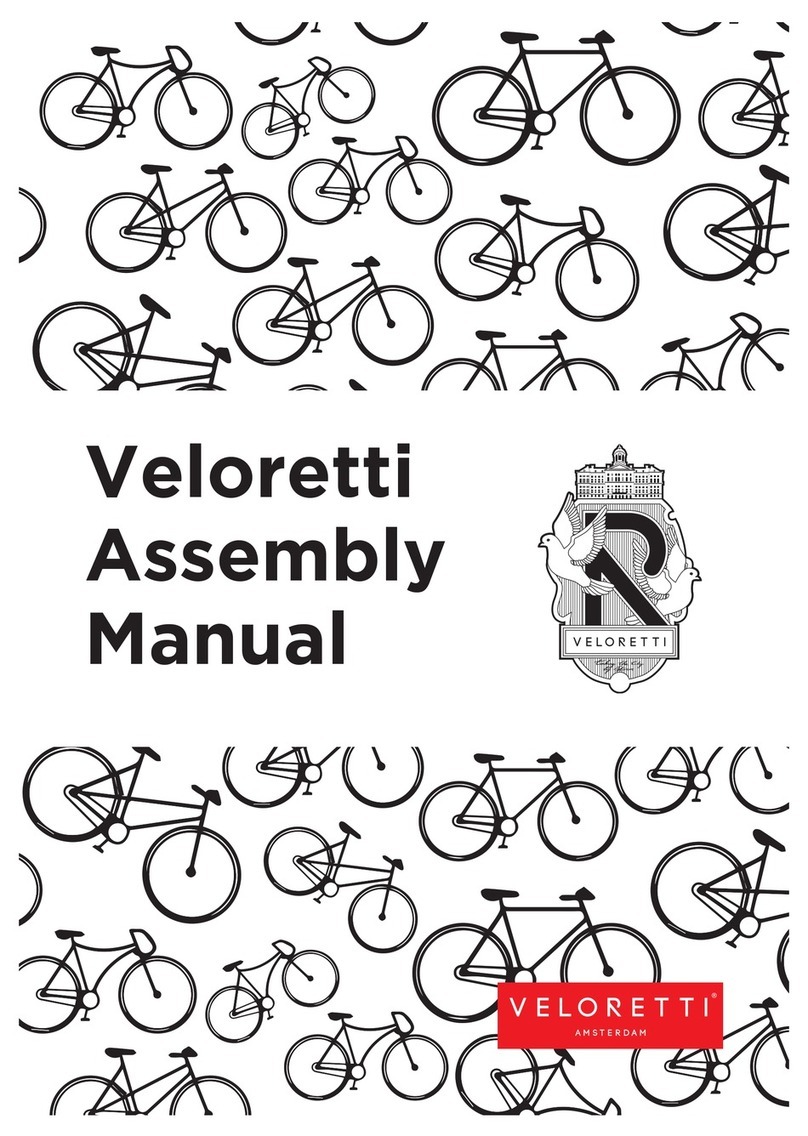
Veloretti
Veloretti Bicycle Assembly manual
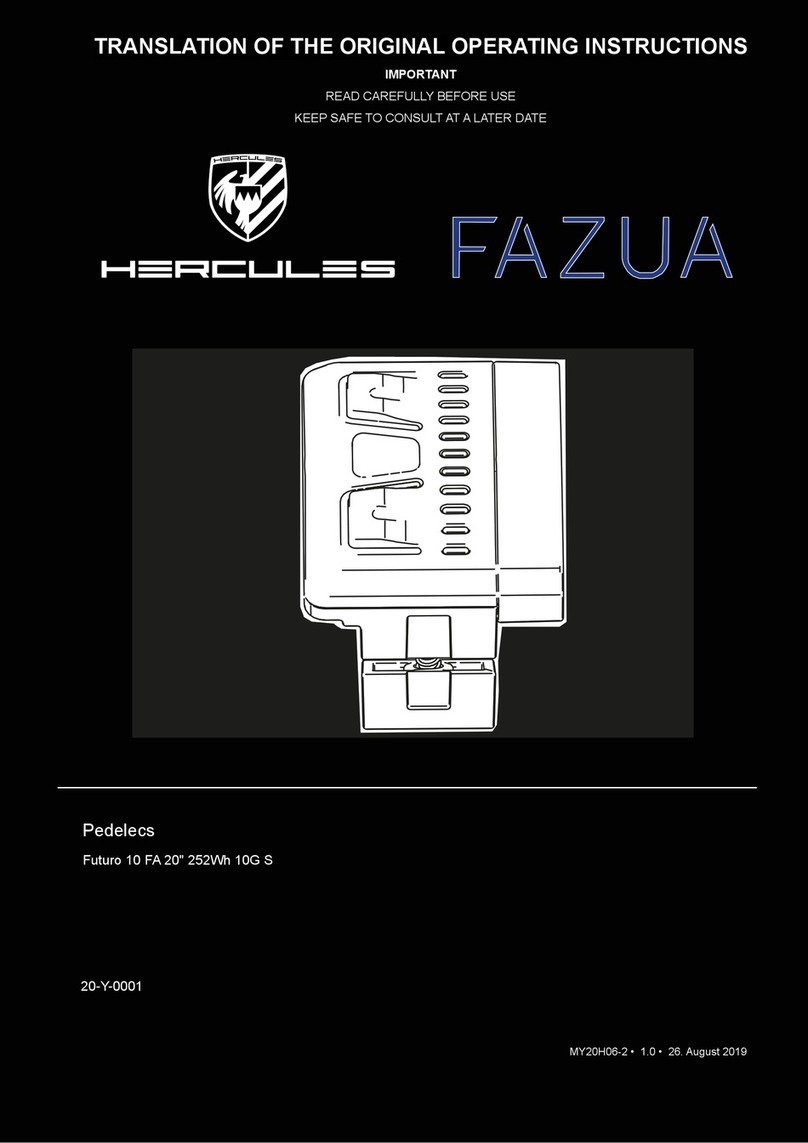
Hercules
Hercules FAZUA Futuro 10 FA 20" 252Wh 10G S Translation of the original operating instructions

Bisshops BV
Bisshops BV BIS210 instruction manual
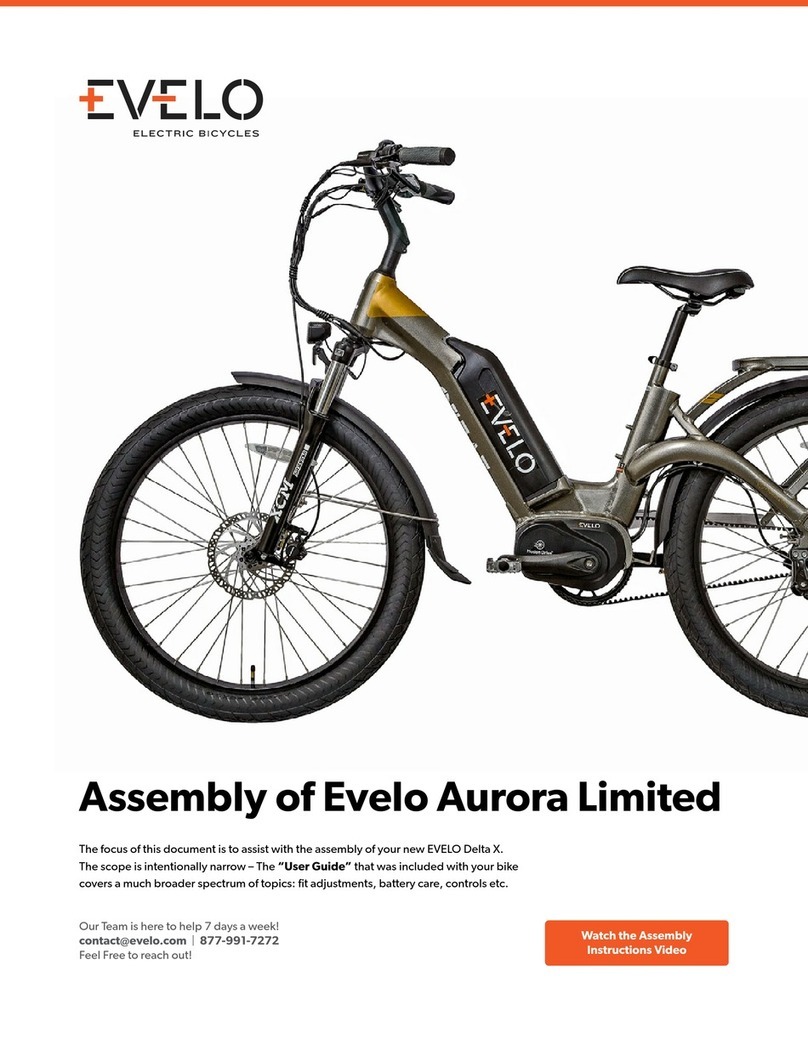
Evelo
Evelo Aurora Limited Edition Assembly
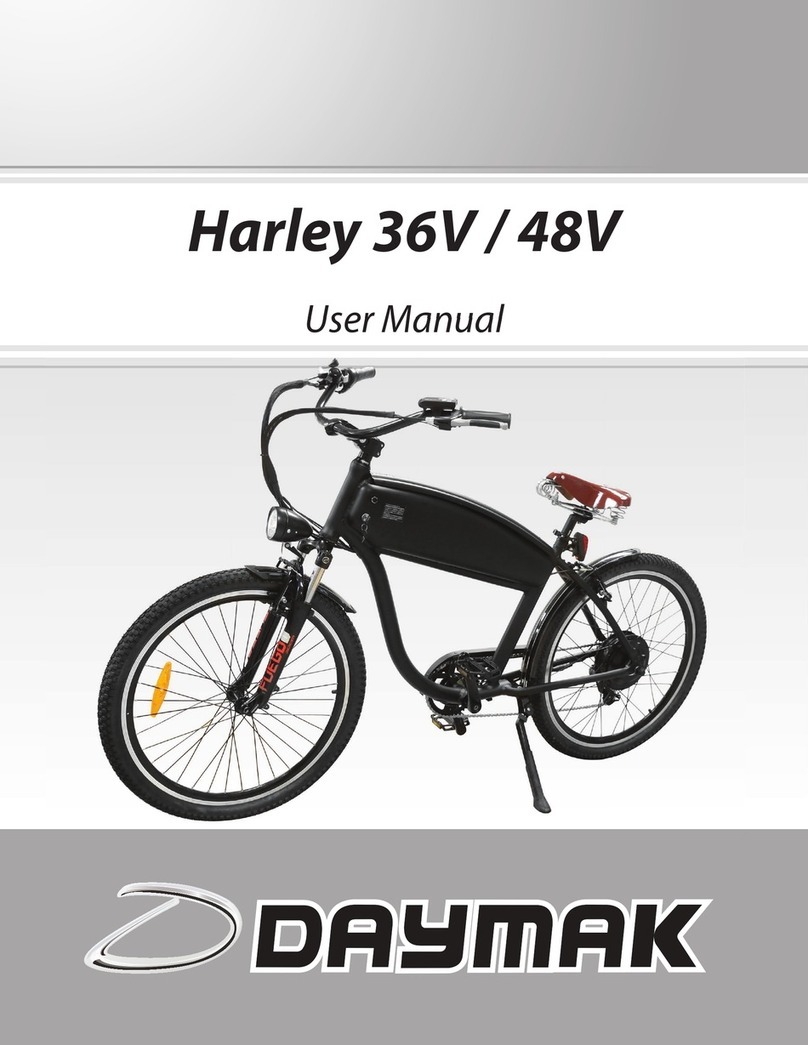
Daymak
Daymak Harley 36V user manual
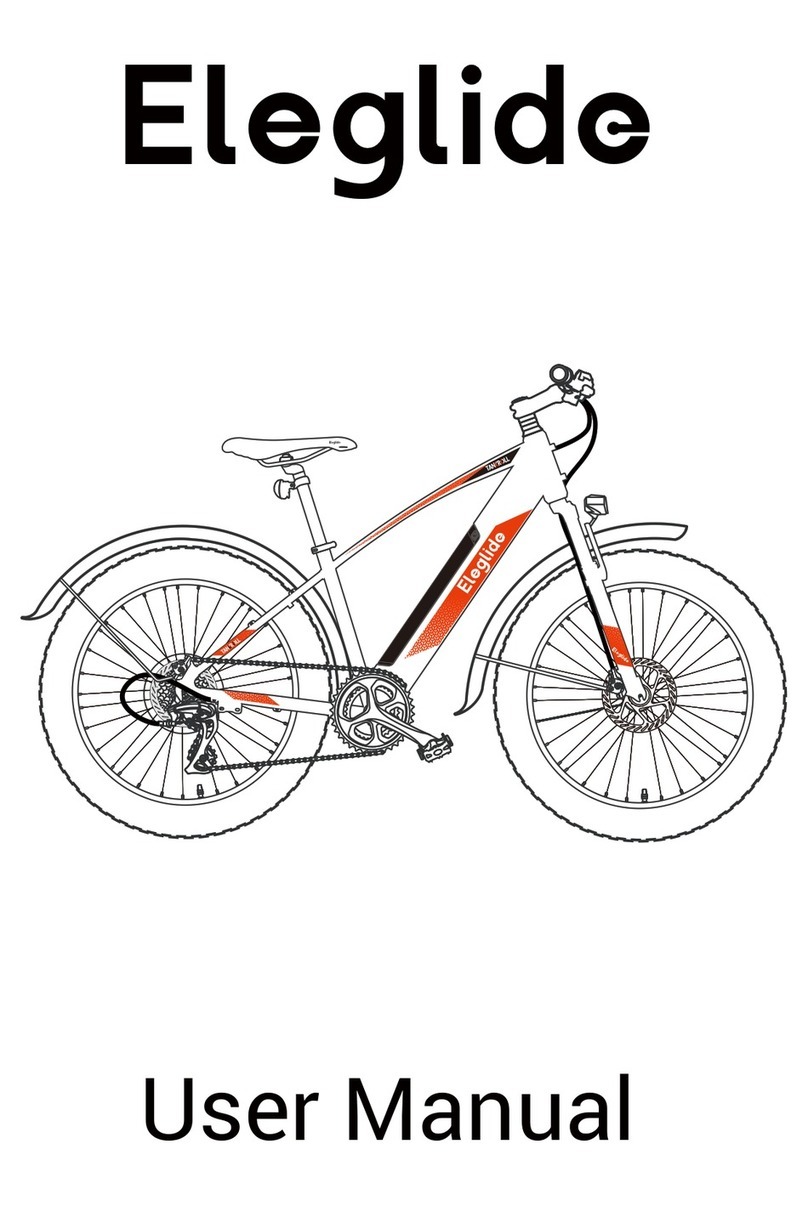
Eleglide
Eleglide Tankroll user manual
